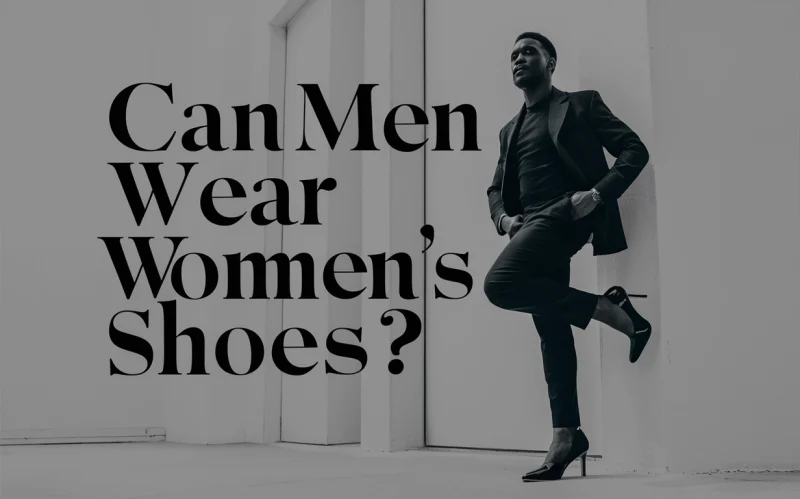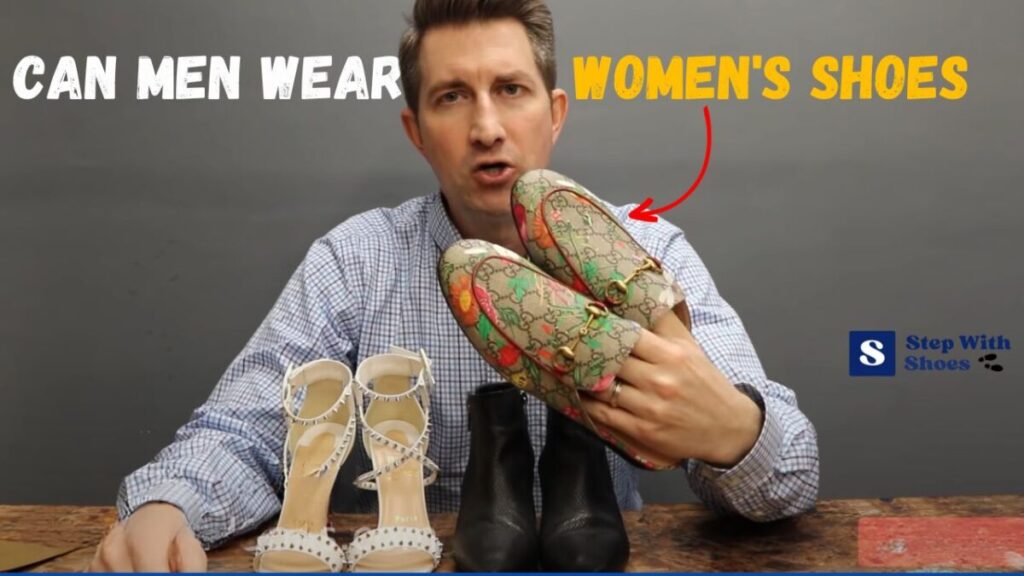The question “Can men wear women’s shoes?” is more than just a simple query about footwear; it’s a reflection of evolving societal norms, the blurring of gender lines in fashion, and the increasing acceptance of personal expression. In a world that’s slowly but surely moving away from rigid definitions of masculinity and femininity, the idea of a man donning a pair of women’s shoes is no longer as shocking as it once was. This shift is fueled by a growing awareness of the importance of inclusivity, self-acceptance, and the freedom to choose one’s own style, regardless of traditional gender roles. The relevance of this topic extends far beyond the realm of fashion. It touches upon issues of identity, personal freedom, and the dismantling of outdated stereotypes. The current context is one of unprecedented openness, where the fashion industry, social media, and everyday conversations are actively challenging conventional boundaries and celebrating diversity.
The fashion industry, a powerful engine of cultural change, has embraced gender fluidity with open arms. Designers are creating collections that defy traditional gender norms, and retailers are increasingly offering unisex options. Social media platforms provide a space for individuals to share their personal styles, inspiring others to experiment and embrace their individuality. The rise of influential figures, both celebrities and everyday individuals, who openly challenge gender stereotypes has further normalized the idea of cross-dressing and the wearing of clothing items traditionally associated with the opposite sex. The focus has shifted from conformity to self-expression, from adhering to rigid rules to celebrating personal choices. This discussion isn’t just about shoes; it’s about the freedom to be oneself, without judgment or constraint.

The conversation around men wearing women’s shoes is a fascinating intersection of fashion, culture, and personal identity. It prompts us to question the very nature of gender and its connection to clothing. Is a shoe simply a functional item, or does it carry inherent gendered meaning? This is a topic ripe for exploration, filled with practical considerations, historical context, and, ultimately, a celebration of individual style. This article aims to delve deep into this evolving discussion, providing a comprehensive overview of the topic and empowering readers with the knowledge and confidence to form their own informed opinions. It will examine the various aspects of this trend, exploring the benefits, challenges, and the future of fashion in a world that is becoming increasingly accepting and inclusive.
Historical and Cultural Perspectives
The concept of gendered footwear isn’t a universal constant; its origins and evolution are intertwined with societal norms and cultural practices. Understanding the historical and cultural context of men wearing women’s shoes provides crucial insights into the present-day acceptance (or resistance) to this practice. Throughout history, footwear has served not only as protection for the feet but also as a powerful symbol of social status, gender, and cultural identity. In some cultures, shoes have been reserved for specific classes or genders, reflecting the prevailing social hierarchies. The history of footwear is, in essence, a history of power, privilege, and the ever-evolving relationship between humans and their surroundings.
Ancient Origins and Early Examples
Tracing the origins of gendered footwear is a complex endeavor, as archaeological evidence is often fragmented and open to interpretation. However, early examples suggest that footwear was primarily functional, designed to protect the feet from the elements. The distinction between men’s and women’s footwear was less pronounced, with basic sandals and moccasins being worn by both sexes. In ancient civilizations, such as Egypt and Greece, sandals were common, with variations in design and ornamentation reflecting social status rather than gender. The concept of specific shoe designs for men and women evolved gradually, influenced by cultural practices and evolving aesthetic preferences. Early shoe designs were often simple and practical, but as societies developed, so did the complexity and variety of footwear.
Footwear in Ancient Egypt and Greece
In ancient Egypt, sandals were worn by both men and women, though the materials and embellishments might have varied. The elite often wore sandals made of leather, adorned with precious metals and jewels, while the common people wore simpler versions made of papyrus or woven reeds. In ancient Greece, sandals were also the predominant form of footwear. Men and women wore similar styles, but the materials and construction could differ. The Greeks were also known for their use of boots, particularly for military purposes. The emphasis was on practicality and functionality, although some variations existed to denote social status. The footwear reflected the needs and preferences of the time.
The Rise of Gendered Fashion
The demarcation of specific footwear styles for men and women became more pronounced during the Middle Ages and the Renaissance. This shift was influenced by the rise of fashion, social hierarchies, and evolving notions of gender roles. The development of distinct clothing styles for men and women was accompanied by the introduction of footwear designed to complement these styles. The invention of the high heel is a prime example of how fashion and gender roles became intertwined. High heels, initially worn by men for practical reasons, gradually became associated with femininity and elegance, leading to a shift in their usage and symbolism. The rise of tailored clothing, along with specific shoe designs, further solidified the distinction between male and female fashion.
The Influence of the Renaissance and the Victorian Era
The Renaissance and the Victorian era witnessed a significant evolution in the fashion landscape, leading to the solidification of gendered footwear. During the Renaissance, elaborate clothing and footwear became symbols of wealth and status. Men and women adopted distinct styles, and footwear designs reflected these differences. The Victorian era further emphasized the gender divide in fashion, with strict dress codes and social expectations. Women’s footwear became increasingly elaborate and decorative, while men’s footwear remained more functional and understated. The Victorian era solidified the idea that clothing, including footwear, should clearly signal one’s gender.
Cultural Variations and Modern Interpretations
Cultural variations in footwear practices reveal the diverse ways societies have approached gender and fashion. In some cultures, gender roles are less rigid, and footwear choices reflect a greater degree of individual expression. The modern era has witnessed a significant shift towards gender-neutral fashion, with designers creating footwear that challenges traditional norms. The increasing visibility of gender-fluid individuals and the rise of social media have further contributed to this trend. The internet allows for easy access to diverse styles and perspectives, leading to a greater understanding and acceptance of different approaches to fashion. This has resulted in a greater variety of footwear options and a more inclusive fashion landscape.
Examples of Cultural Fluidity in Footwear
Some cultures have historically shown greater fluidity in footwear practices. In certain indigenous cultures, footwear styles have been less rigidly defined by gender, with shared designs and variations in materials and ornamentation. The influence of global fashion has also led to cross-cultural exchange and the adoption of footwear styles from different regions, further blurring the lines between traditional gendered norms. Contemporary fashion trends, such as the adoption of sneakers by both men and women, also demonstrate the increasing fluidity of footwear choices. This is facilitated by a globalized world and the easy availability of diverse styles.
Practical Considerations and Challenges
While the idea of men wearing women’s shoes is gaining acceptance, there are practical considerations and challenges that individuals might encounter. The primary concerns often revolve around fit, comfort, and the potential for social stigma. Understanding these challenges is crucial for anyone considering embracing this fashion choice. It’s not just about liking a particular shoe; it’s also about ensuring that it fits properly, feels comfortable to wear, and aligns with one’s personal style and comfort level. Navigating these practicalities can be a learning experience, but with careful consideration and a willingness to experiment, these challenges can be overcome.
Fit and Sizing Issues
One of the most significant practical considerations is the difference in shoe sizing between men and women. Women’s shoes typically have a narrower width and a different heel-to-toe ratio than men’s shoes. This can lead to fit issues, discomfort, and potential foot problems if the wrong size is chosen. Men’s feet tend to be wider than women’s feet, particularly in the ball of the foot. Wearing shoes that are too narrow can lead to blisters, bunions, and other foot ailments. It’s crucial to understand the sizing differences and consider factors such as width and arch support when selecting women’s shoes. Proper fit is paramount for comfort and long-term foot health.
Understanding Shoe Sizing Conversion
The conversion between men’s and women’s shoe sizes can be tricky. As a general rule, men’s shoes are typically one to two sizes larger than women’s shoes for the same length. However, the width can vary significantly. Many shoe retailers offer size conversion charts to assist customers in finding the correct fit. It’s also advisable to try on shoes before purchasing, especially if buying online. Consulting with a shoe specialist can provide valuable insights and guidance. Understanding how shoe sizing works is crucial for ensuring a comfortable and appropriate fit. This helps to avoid potential foot problems.
Comfort and Functionality
Beyond fit, comfort and functionality are also important factors to consider. Women’s shoes are often designed with different priorities than men’s shoes. High heels, for example, can be less comfortable and less practical for everyday wear than flat shoes or sneakers. The choice of materials, the presence of arch support, and the overall design of the shoe can significantly impact comfort levels. It’s essential to choose shoes that are suitable for the intended activity. A pair of stilettos may be glamorous, but they are not ideal for a long walk or strenuous activity. Functionality should always be considered alongside aesthetics.
Choosing Shoes for Different Activities
The intended use of the shoes should guide the selection process. For everyday wear, comfort and support are paramount. Sneakers, flats, and low-heeled shoes are often good choices. For formal occasions, heels or dress shoes may be appropriate, but it’s essential to prioritize comfort to avoid discomfort. Consider the terrain and the level of activity when selecting shoes. For outdoor activities, sturdy, supportive footwear is essential. Choosing the right shoe for the right activity will enhance comfort and prevent foot injuries. This means understanding your needs and selecting footwear accordingly.
Social and Practical Challenges
Despite the growing acceptance of gender-fluid fashion, individuals may still encounter social stigma or practical challenges when wearing women’s shoes. This can range from curious stares to outright disapproval. It’s important to be prepared for potential reactions and to develop strategies for navigating these situations. Practical challenges may also arise, such as difficulty finding appropriate sizes or styles. Some retailers may not carry a wide selection of women’s shoes in larger sizes. Navigating these challenges requires self-confidence, a willingness to experiment, and a clear understanding of one’s personal style and preferences. It’s about being true to yourself and not letting societal expectations dictate your choices.
Navigating Social Reactions and Overcoming Stigma
Dealing with social reactions requires self-awareness and confidence. It’s important to remember that the opinions of others do not define your worth. Having a strong sense of self and a clear understanding of your motivations can help you navigate potentially awkward situations. It’s also important to educate yourself about the history and context of gender-fluid fashion. This knowledge can help you engage in informed conversations and respond to questions or criticisms with grace and confidence. Remember, the goal is to express yourself authentically. Stigma can be challenged by demonstrating confidence in your choices.
Benefits of Wearing Women’s Shoes
The decision for men to wear women’s shoes, beyond the potential challenges, presents numerous benefits. These range from enhancing personal style and self-expression to exploring a wider range of fashion options and embracing a more inclusive approach to clothing. The advantages extend beyond mere aesthetics and can contribute to increased self-confidence, a sense of freedom, and the breaking down of societal barriers. It’s a bold statement of individuality, a way to challenge the status quo, and a celebration of personal choice. It’s about embracing the opportunity to express yourself and to enjoy the freedom of choosing your own style.
Expanding Style and Personal Expression
One of the most significant benefits is the ability to expand one’s style and express their personality more fully. Women’s shoe designs often offer a wider variety of styles, colors, and embellishments than men’s shoes. This allows for greater creativity and the opportunity to experiment with different looks. A man who embraces women’s shoes can incorporate unique and eye-catching footwear into his wardrobe, adding a distinctive touch to his overall style. This can be a liberating experience, allowing individuals to break free from the constraints of traditional gender norms and to embrace their unique sense of fashion. It is a way to express individuality and to showcase one’s personal aesthetic.
Exploring a Wider Range of Styles
Women’s shoes offer a diverse range of styles that are often unavailable in men’s footwear. This includes a wider selection of heels, sandals, boots, and flats, each with its own unique aesthetic appeal. This expanded palette allows individuals to experiment with different looks, from elegant and sophisticated to bold and edgy. The opportunity to explore such a variety of styles can be exciting and transformative, allowing for the creation of unique and personalized outfits. This gives an individual the ability to mix and match and find what best expresses their personality. The availability of different styles provides a creative playground for fashion enthusiasts.
Embracing Inclusivity and Challenging Norms
Choosing to wear women’s shoes can be an act of defiance against traditional gender norms, contributing to a more inclusive and accepting society. It challenges the rigid boundaries that have historically defined fashion and encourages a more fluid and open approach to self-expression. By embracing this fashion choice, individuals contribute to the normalization of gender-fluid clothing, creating a more welcoming environment for those who identify outside of traditional gender roles. This can lead to a greater sense of acceptance and understanding within communities. It also encourages the breaking down of harmful stereotypes, fostering a society where individuals can express themselves freely.
Promoting Gender Fluidity and Acceptance
The act of wearing women’s shoes can serve as a powerful symbol of gender fluidity, demonstrating that clothing is not inherently tied to gender. It encourages conversations about gender identity and challenges the assumption that certain clothing items are exclusively for one gender. This visibility helps to normalize gender-fluid expressions and fosters greater acceptance of diverse identities. By wearing women’s shoes, men can become advocates for inclusivity, helping to create a more tolerant and understanding society. This can inspire others to embrace their own identities and to challenge the restrictions of traditional gender norms.
Personal Empowerment and Self-Confidence
Wearing women’s shoes can be a source of personal empowerment and increased self-confidence. It can be a way to challenge one’s comfort zone, to embrace one’s individuality, and to express one’s authentic self. When individuals choose to wear what makes them feel good, regardless of societal expectations, they often experience a boost in self-esteem and a greater sense of self-acceptance. This newfound confidence can have a positive impact on all aspects of their lives. It can improve their relationships, their professional success, and their overall well-being. It’s about owning one’s choices and feeling comfortable in one’s own skin.
Boosting Self-Esteem and Self-Acceptance
Making a bold fashion choice, such as wearing women’s shoes, can be a transformative experience, leading to increased self-esteem and self-acceptance. It requires a degree of courage to go against the grain and to embrace one’s individuality. This act of self-expression can be incredibly empowering, fostering a sense of pride and confidence. When individuals feel comfortable and confident in their appearance, they often project a more positive image to the world. This can lead to improved relationships, increased opportunities, and a greater sense of personal fulfillment. It’s about learning to love and accept oneself, flaws and all.
Practical Applications and Advice
For men considering wearing women’s shoes, there are several practical applications and pieces of advice that can help to ensure a positive and successful experience. From selecting the right size and style to knowing where to shop and how to style the shoes, these tips provide a valuable guide for anyone embarking on this fashion journey. The goal is to make the process enjoyable and empowering, allowing individuals to express their personal style with confidence and ease. This guide will equip individuals with the knowledge and resources they need to navigate the world of women’s shoes.
Finding the Right Fit and Style
The key to a successful experience is finding shoes that fit properly and complement one’s personal style. This begins with understanding shoe sizing and the potential differences between men’s and women’s sizes. It’s essential to measure one’s feet and to consult size charts before making a purchase. Experimenting with different styles is also important. Consider factors such as heel height, width, and the overall design of the shoe. Try on different styles to find what feels most comfortable and suits one’s personal aesthetic. Proper fit and style are critical to both comfort and confidence.
Measuring Your Feet and Using Size Charts
Accurate foot measurements are essential for finding the right shoe size. Measure the length and width of your feet using a ruler or measuring tape. Compare these measurements to the size charts provided by the shoe manufacturer or retailer. It’s also advisable to try on shoes before purchasing, especially if buying online. If possible, visit a shoe store to try on different styles and sizes. This will help to ensure a comfortable and appropriate fit. Understanding the specifics of sizing is crucial for a successful outcome.
Shopping and Styling Tips
Knowing where to shop and how to style women’s shoes can greatly enhance the experience. Explore different retailers, both online and in-store, to find a wide selection of styles and sizes. Consider visiting specialty shoe stores or boutiques that cater to diverse clientele. Experimenting with different outfits and finding what looks best is also part of the process. Consider the overall aesthetic and the occasion when selecting shoes. Start with subtle choices, such as flats or low-heeled shoes, if you’re new to wearing women’s shoes. The goal is to create a cohesive and stylish look.
Where to Shop and How to Style the Shoes
There are numerous options for purchasing women’s shoes. Online retailers offer a vast selection and often have detailed size charts and customer reviews. Department stores and specialty shoe stores also carry a variety of styles. Consider visiting consignment shops or thrift stores for unique finds. When styling women’s shoes, consider the overall outfit and the occasion. Experiment with different pairings to find what works best. Confidence is key, so wear the shoes with pride. Consider starting with less obvious styles and then gradually exploring more adventurous options.
Building Confidence and Overcoming Obstacles
Building confidence and overcoming any obstacles that may arise is essential for enjoying the experience of wearing women’s shoes. Start by wearing the shoes in comfortable and familiar settings, gradually expanding your comfort zone. Surround yourself with supportive friends and family members. Practice responding to any questions or comments with confidence and grace. Remember that the goal is to express yourself authentically and to enjoy the freedom of personal expression. The more comfortable you become, the easier it will be to embrace this fashion choice. The key is to be confident and true to yourself.
Tips for Building Confidence and Navigating Social Situations
Building confidence involves practicing self-acceptance and embracing your individuality. Wear the shoes with pride and confidence, and let your personality shine. Practice responding to any questions or comments with a calm and confident demeanor. Surround yourself with supportive people who understand and appreciate your choices. Remember that you are in control of your own appearance and that you have the right to express yourself freely. Confidence comes from within, so focus on your own self-worth and your ability to be yourself.
Summary and Recap
The question of whether men can wear women’s shoes has evolved from a simple fashion query to a complex exploration of gender, identity, and personal expression. The historical context reveals how footwear has historically been gendered, reflecting societal norms and cultural practices. However, the modern era has witnessed a growing trend towards gender-fluid fashion, with designers and consumers challenging traditional boundaries. The benefits of men wearing women’s shoes are numerous, ranging from expanding style options and embracing inclusivity to boosting self-confidence. While challenges exist, such as fit and sizing issues, these can be addressed with careful consideration and informed choices.
The practical applications of wearing women’s shoes involve finding the right fit, experimenting with different styles, and knowing where to shop. Understanding shoe sizing, both men’s and women’s, is crucial. Experimenting with different styles helps to define personal preferences. This can involve flats, heels, boots, or sandals. There are plenty of retailers, both online and in-store, offering a wide range of options. Building confidence and navigating social situations requires self-awareness and a strong sense of self. The key to success is self-acceptance, confidence, and a willingness to express oneself authentically.
The journey of wearing women’s shoes is a personal one, filled with opportunities for self-discovery and self-expression. It’s about breaking free from the constraints of traditional gender roles and embracing the freedom to choose one’s own style. It’s about challenging societal norms and promoting inclusivity. It’s about finding joy and confidence in expressing one’s authentic self. It is an invitation to explore the vast and diverse world of fashion and to express oneself without limitations. This is a celebration of individuality and a testament to the power of personal choice.
Ultimately, the answer to “Can men wear women’s shoes?” is a resounding yes. The only limitations are those imposed by societal expectations and self-doubt. The ability to embrace this fashion choice is a powerful statement of self-acceptance and a celebration of individual style. The evolution of this trend mirrors a larger shift in society, where gender fluidity and personal expression are increasingly celebrated. The future of fashion is inclusive, and the possibilities are endless.
Frequently Asked Questions (FAQs)
Is it okay for men to wear women’s shoes?
Yes, absolutely. There are no inherent rules preventing men from wearing women’s shoes. It is a matter of personal preference, style, and comfort. The practice is increasingly accepted and celebrated as part of the larger trend of gender-fluid fashion and self-expression.
What are the main challenges men might face when wearing women’s shoes?
The primary challenges involve fit and sizing, as women’s shoe sizes often differ from men’s sizes. Comfort can also be an issue, particularly with styles like high heels. Social reactions, though becoming less frequent, can still be a concern. It is essential to choose shoes that fit properly, feel comfortable, and align with one’s personal style.
How can men find the right size and fit in women’s shoes?
Men should measure their feet accurately and compare their measurements to size charts. It is also advisable to try on shoes whenever possible. Consulting with shoe specialists or using online size conversion tools can also be helpful. Be aware that women’s shoes may have a narrower width than men’s shoes.
What types of women’s shoes are most comfortable for men?
Comfort depends on individual preferences. Flats, sneakers, and low-heeled shoes often provide more comfort than high heels. Consider the materials, arch support, and overall design of the shoe. Choosing shoes designed for comfort and support is essential for everyday wear. Experimenting with different styles helps to find what works best.
Where can men find women’s shoes to purchase?
Women’s shoes are available at department stores, specialty shoe stores, and online retailers. Consider exploring options like consignment shops and thrift stores for unique finds. Look for stores that offer a wide variety of styles and sizes, and consider reading customer reviews before making a purchase.



